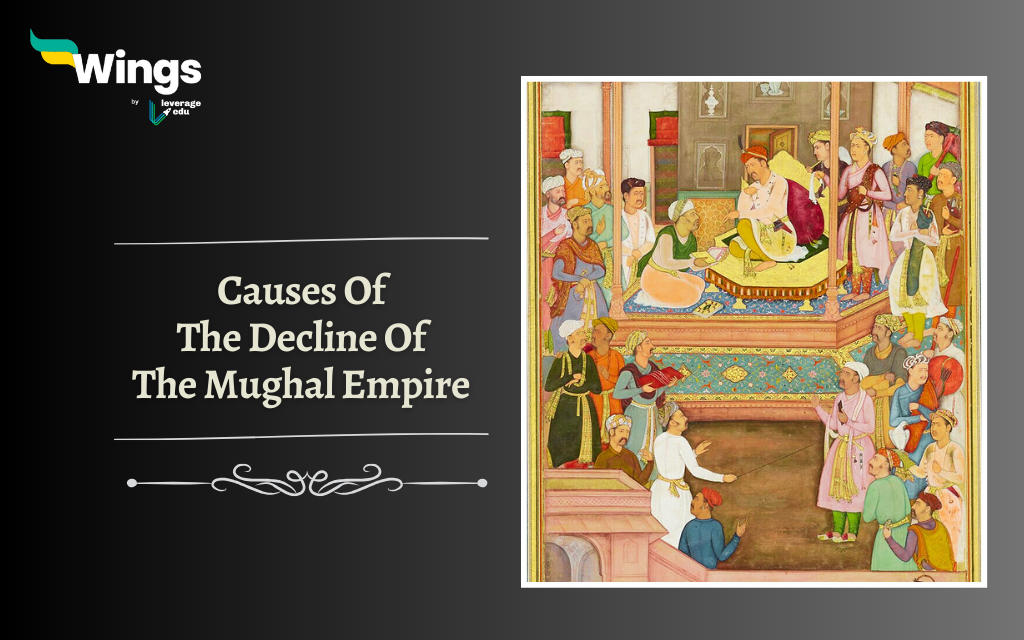The Mughal Empire was one of the mightiest and most powerful dynasties of all time in the history of India. They ruled over the Indian sub-continent from 16th to 18th century. Established by Babur in the year 1526, the dynasty reached its zenith under the rule of Emperor Akbar. The Empire also saw the rule from great Mughal emperors like Shah Jahan to Aurangzeb, but after the reign of Aurangzeb, no prominent leader was able to reach the title of greatness. Thus, over time, the empire started to weaken and eventually crumbled. There are many other factors that could be causes of the decline of the Mughal Empire. Let us find them together –
Contents
Reasons for the Decline of the Mughal Empire
A combination of weak succession planning, economic drain, religious intolerance, invasions, administrative corruption, military defeats, revolts, agrarian crisis, cultural decline and external interference all played a role in the empire’s decline.
Economic Factors :
- Erosion of Revenue Base: As the empire expanded, the revenue base also began to erode due to excessive military spending and administrative inefficiencies.
- Decline in Trade and Commerce: The decline in trade and commerce which was coupled with heavy taxation, led to a stagnation in the economic growth of the empire.
- Inflation: The unchecked inflation further strained the economy, making it difficult for the empire to sustain itself financially.
Also Read – Mughal Emperor Jahangir: Life, Legacy, and Influence
Political Instability:
- Weak Succession Planning: The lack of a clear succession plan led to power struggles among the Mughal rulers which resulted in political instability.
- Rebellions and Revolts: The empire faced numerous rebellions and revolts from regional powers like the Marathas and British India Company, weakening its hold over the vast territories it once controlled.
- Foreign Invasions: The Mughal Empire faced continuous threats from foreign invaders like the Dutch, Portuguese and French, further exacerbating the political turmoil within the empire.
Administrative Failures:
- Corrupt Practices: Corruption within the administrative ranks of the empire undermined the efficiency of governance and used up all the public trust in the Mughal administration.
- Decentralization: The decentralization of power to regional governors led to a loss of central authority and unity within the empire.
- Lack of Reforms: The failure to adapt to changing times and implement necessary administrative reforms became a cause of the decline of the empire.
According to historian Satish Chandra, One of the causes of the decline of the Mughal Empire was the crisis of Mansabdari- Jagirdari. In his thesis, Parties and Politics of the Mughal Court (1959), he pointed out the disarray in which the system of jagirdari fell, which was bound to collapse, leading to the decline of the empire.
Also Read – Mughal Family Tree: A List of Mughal Emperors
Social Unrest:
- Religious Intolerance: The imposition of religious policies that marginalised certain communities led to social unrest and discord within the empire.
- Caste System: The rigid caste system entrenched within society hindered social mobility and perpetuated inequality, leading to discontent among the population.
- Cultural Decline: The decline in cultural and artistic patronage by the Mughal rulers further alienated the population.
Also Read – Birbal: An Overview of Mughal Emperor’s Advisor
Military Weakness:
- Lack of Modernization: The failure to modernise the military and adapt to new warfare techniques put the Mughal Empire at a disadvantage against emerging powers.
- Mercenary Armies: Relying heavily on mercenary armies weakened the loyalty of the military forces and compromised the defence capabilities of the empire.
- Inadequate Training: Inadequate training of soldiers and lack of centralised command structure further weakened the military power.
The last ruler of the Mughal Empire was Bahadur Shah Zafar also known as Bahadur Shah II. In the revolt of 1857, he was exiled to Rangoon, Burma( present-day Myanmar), and he died in the year 1862.
Other Theories
- M. Athar Ali, a historian based his hypothesis on the lack of the functioning of the Jagirdari System in his work “Mughal Nobility under Aurangzeb (1966).
- Another theory by Irfan Habib came to light in his work Agrarian System of Mughal Empire (1963). He pointed out that there was an increase in the prevalence of the Agrarian Crisis.
- J.F Richards, another historian, came up with the cause of the decline of the Mughal Empire because of the state of Bejagiri in the society.
Relevant Blogs
| Who Is The Father Of Akbar? | Who Is Shivaji Maharaj’s Son? |
| How did Qutbuddin Aibak die? | Who Defeated Akbar? |
| How Many Wives Did Akbar Have? | Who Built Humayun Tomb? |
| The Treaty of Purandar Between Maratha and British | How Did Ashoka Die? |
| Who Defeated Jahangir? | Where is the Tomb of Jahangir? |
| How Did Shivaji Maharaj Died? | How Did Tenali Rama Died? |
This was all about the causes of the decline of the Mughal empire. If you want to know more about topics like this, then visit our general knowledge page! Alternatively, you can also read our blog on general knowledge for competitive exams!
 One app for all your study abroad needs
One app for all your study abroad needs














